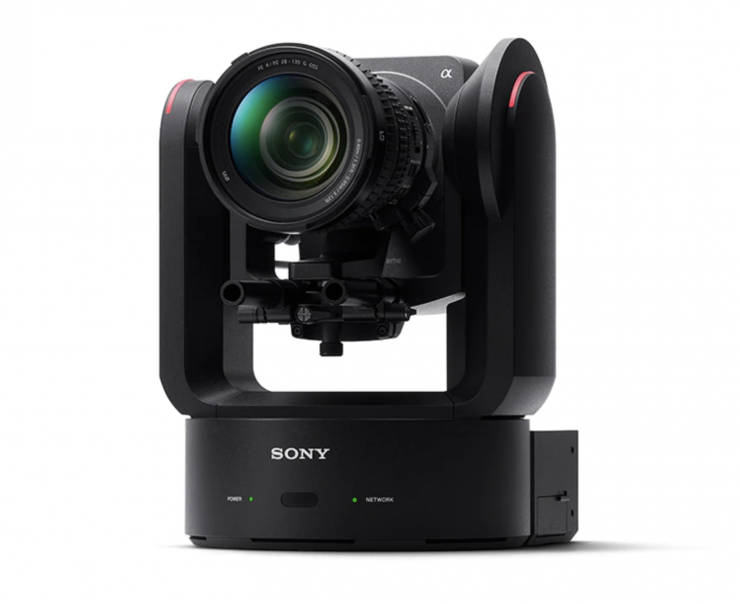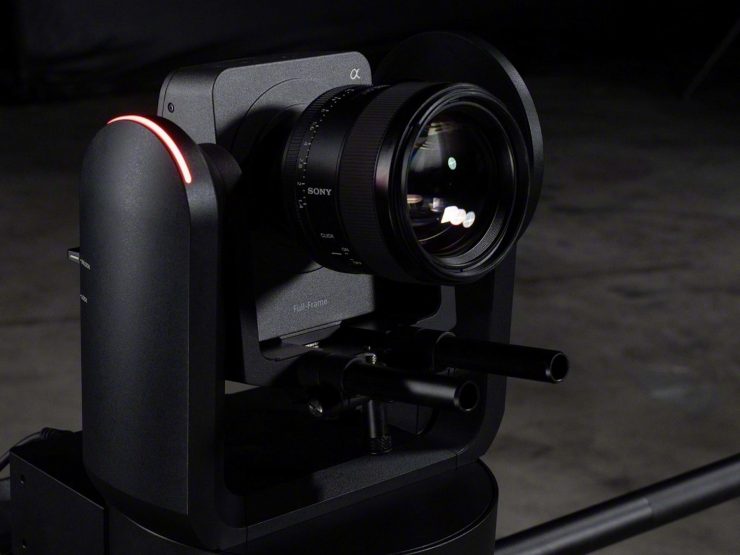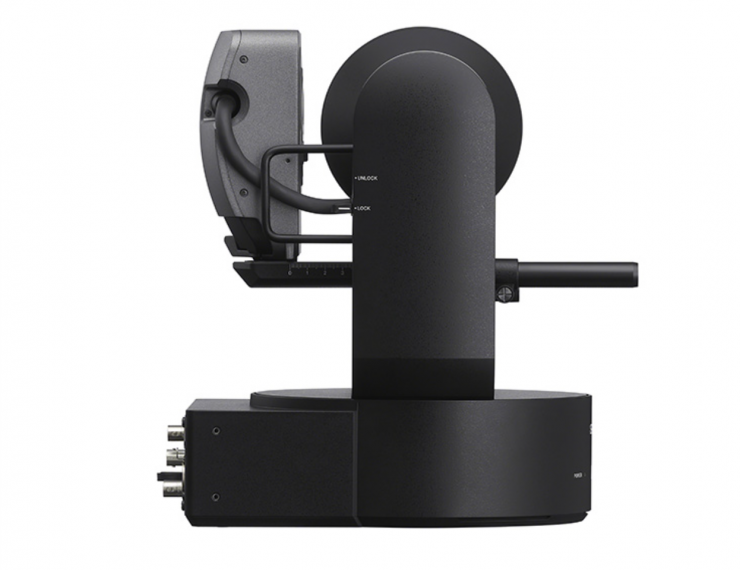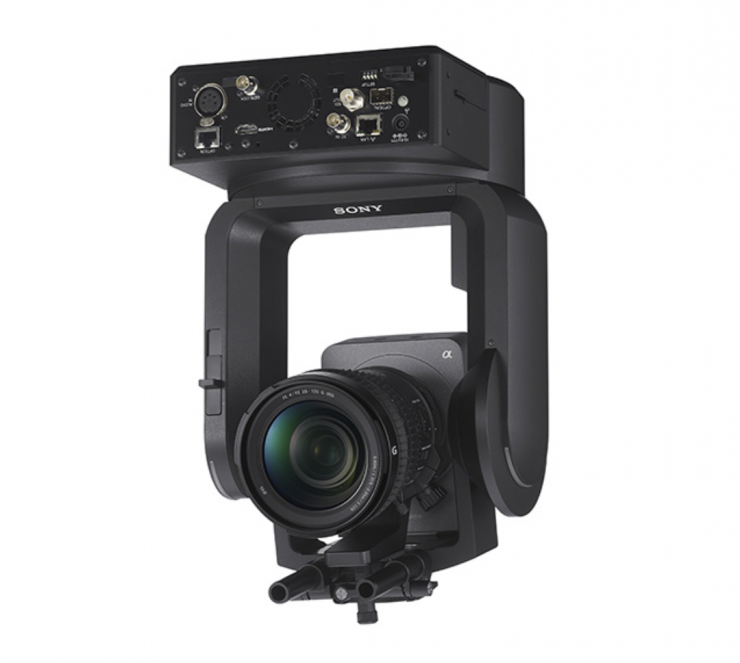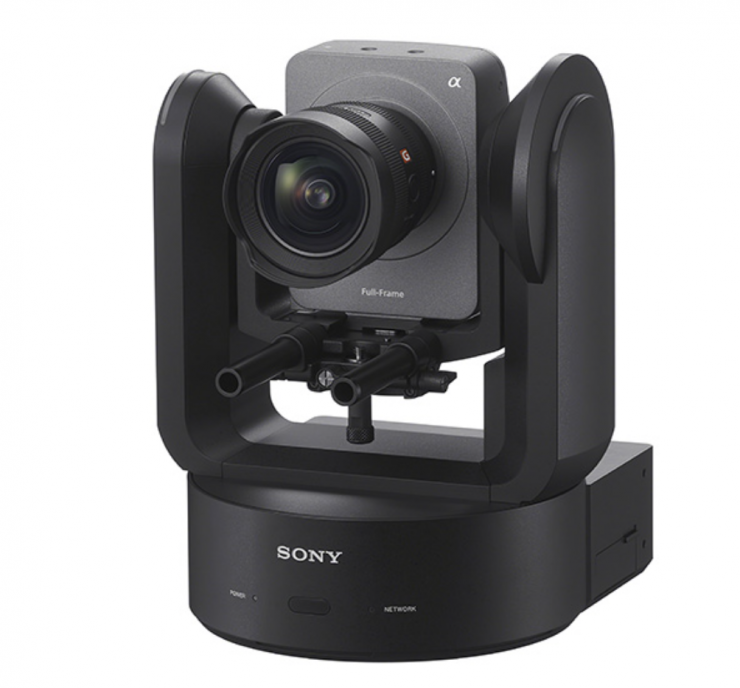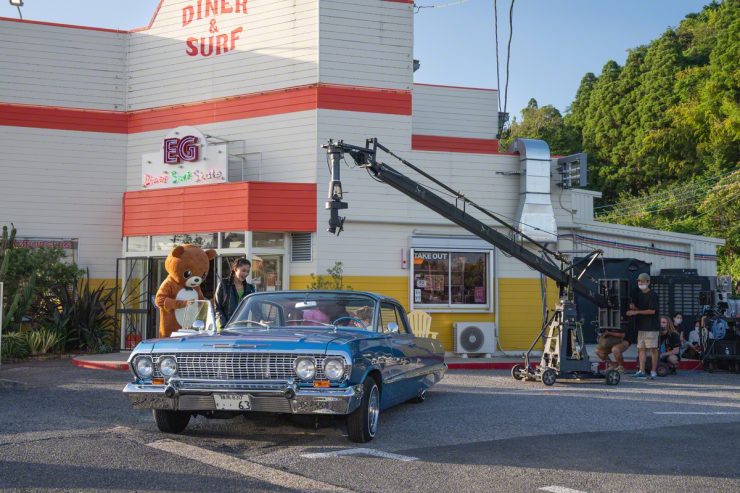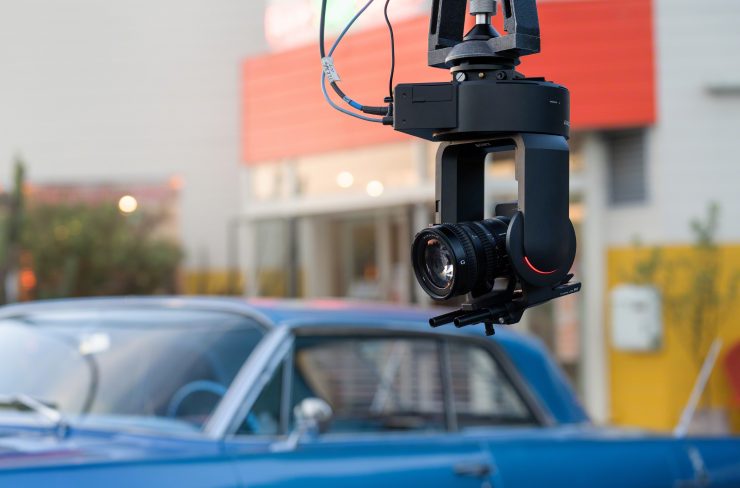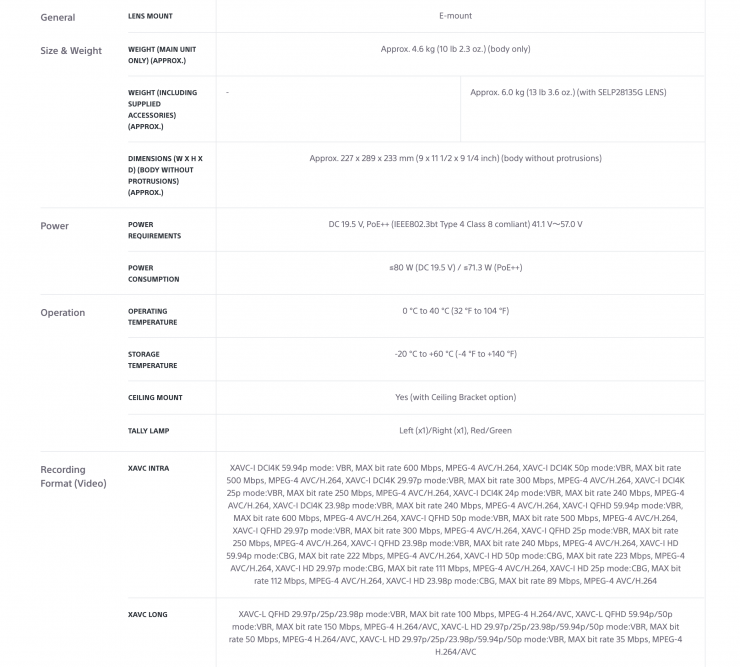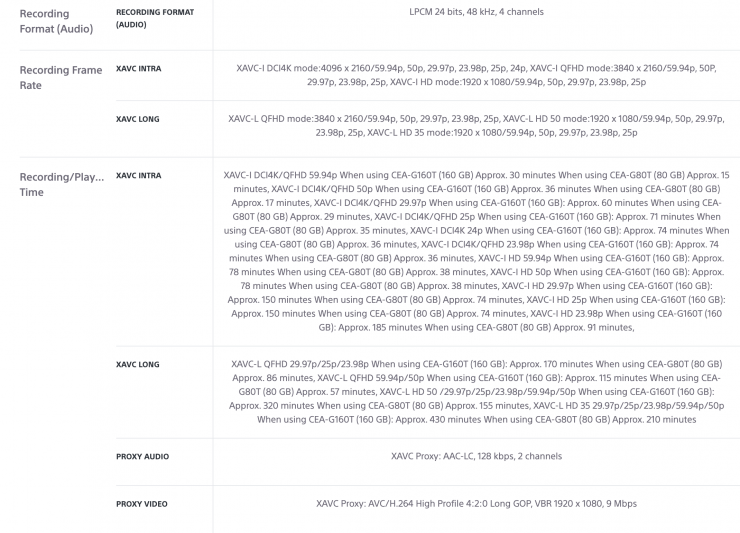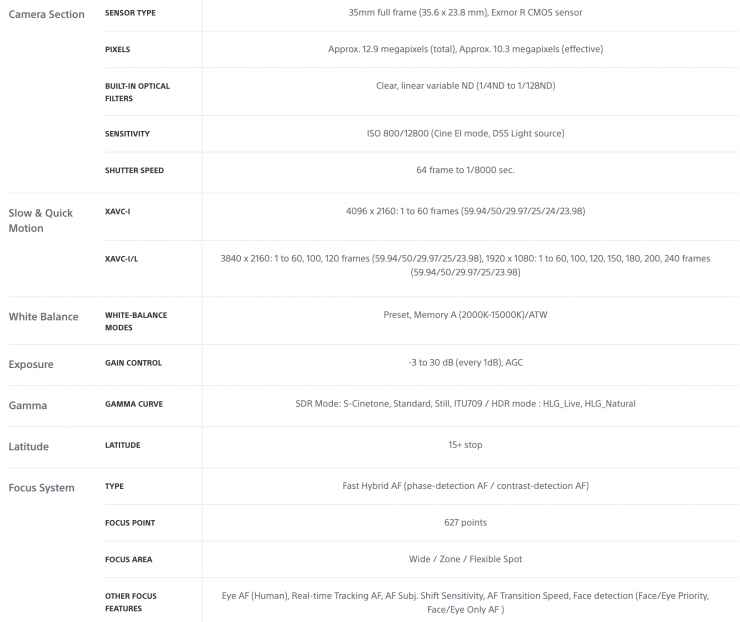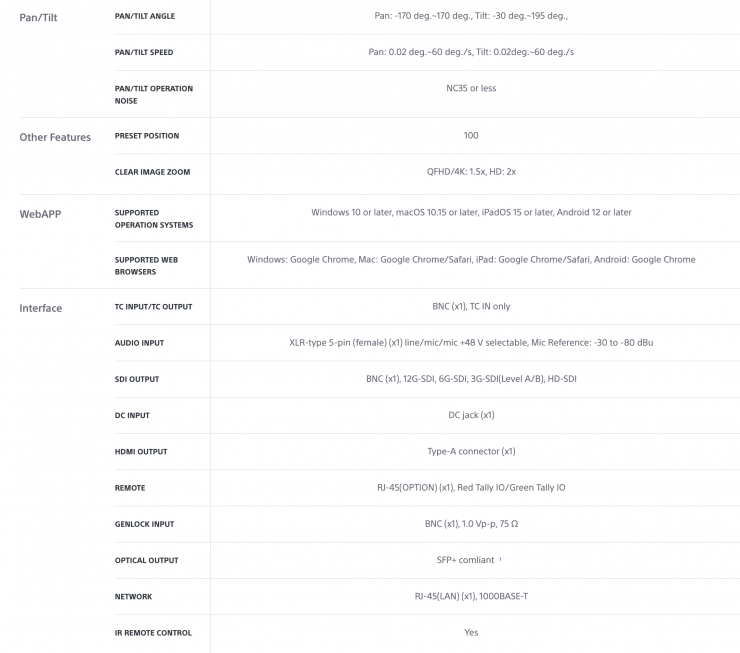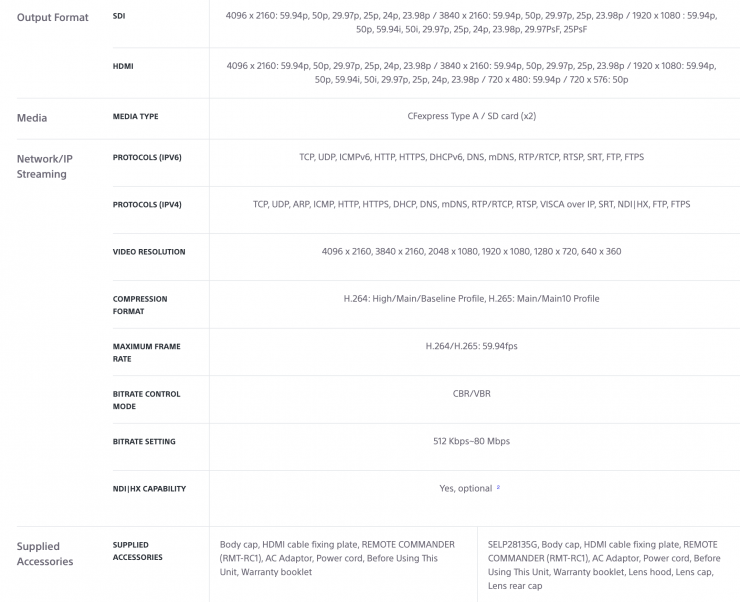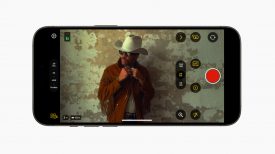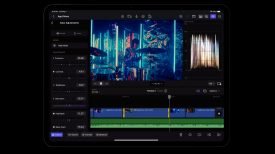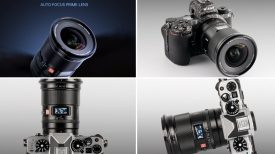Sony has announced the FR7, a full frame interchangeable lens PTZ camera with variable electronic ND.
Just to be crystal clear, the FR7 isn’t a gimbal, nor is it a hybrid gimbal/camera like the DJI Ronin 4D. It is a stand-alone PTZ camera that will be used on live shows, concerts, sporting events, house of worship applications, etc.
Key features
- Supports up to UHD 4K120 Video
- Sony E-Mount Lens Interchangeability
- 4K Full-Frame Sensor
- 12G-SDI, HDMI & Streaming Output
- Variable Electronic ND Filter
- Smooth, Slow Pan & Tilt Movement
- IR, IP & Web App Remote Control
- Flexible PoE+ Installation
- Genlock, Timecode & Tally Lamps
This isn’t Sony’s first rodeo. They have made PTZ cameras in the past, but they all utilized smaller-sized sensors and integrated optics.
You can watch the official product announcement above.
Concept
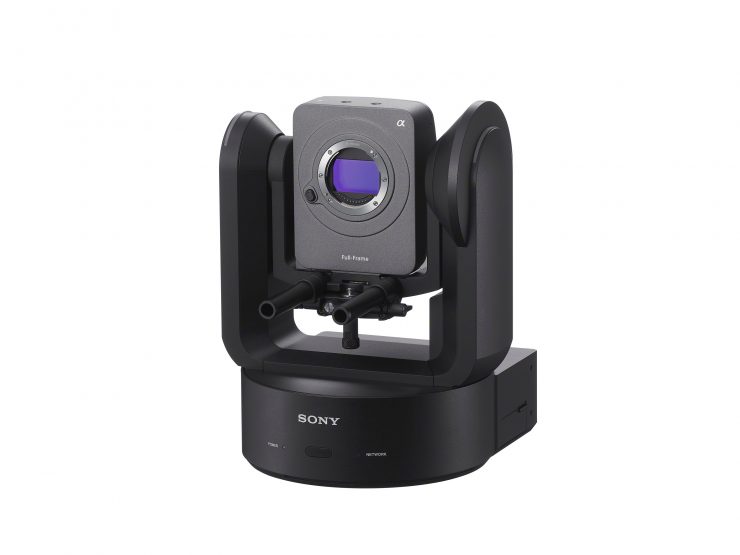
The whole concept behind the FR7 was to make a PTZ camera that could seamlessly work alongside other Sony Cinema Line cameras in live or multi-camera environments.
By utilizing a common sensor and the same image processing that several Sony cameras in the Cinema Line have, you can mix and match cameras and have them all match very closely. In fact, the FR7 is actually part of Sony’s Cinema Line.
Great image quality is not something you usually associate with a lot of PTZ cameras. They tend to use smaller-sized sensors with limited dynamic range and the image quality often leaves a lot to be desired. With the FR7 you are arguably going to get a lot better quality images than you would when using most other PTZ cameras. That’s not to say other PTZ cameras are terrible because they are not. There is a place for smaller-sized sensors and integrated lenses that offer a big focal reach. Your choice of what PTZ camera to use really comes down to the requirements and the application.
You could also use the FR7 on a jib, crane, slider, dolly, etc. but to be honest, there are probably better solutions for doing that. An FX3 on a gimbal attached to any of these devices could achieve the same result.
Sensor
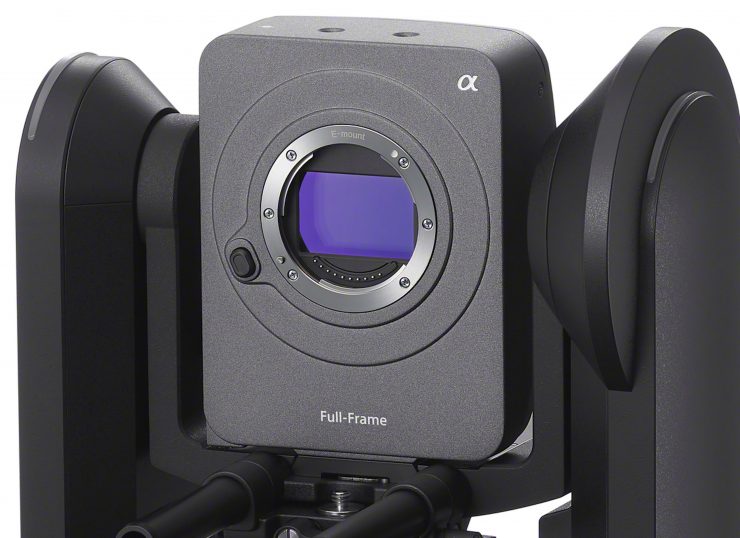
The camera is using the same full-frame, back-illuminated 12.9MP (35.6 x 23.8 mm) Exmor R CMOS sensor (Approx. 10.3 megapixels effective) and BIONZ XR processor that is found in the FX3, FX6, and a7S III. Sony won’t actually confirm that it is the same sensor, all they will say is that it is a very similar sensor. This is the first time that a PTZ camera has utilized a full-frame sensor.
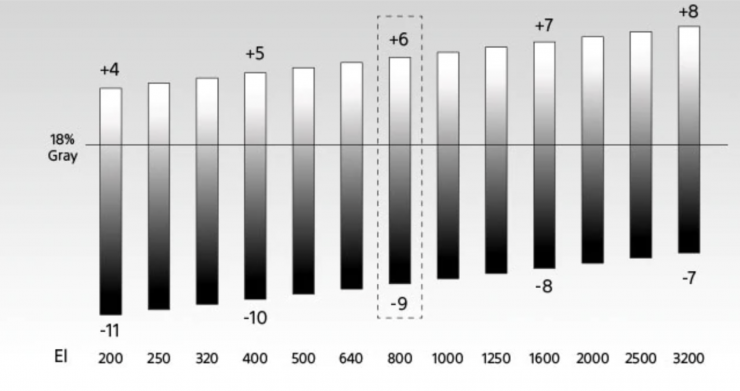
Just like the FX6, it has a base ISO of 800 as well as an ISO 12800 high-sensitivity mode, and a claimed 15+ stops of dynamic range.
The sensor block is a self-contained unit and all of the processing and recording are done at the base of the FR7. In a lot of ways, the FR7 is like a little mini Rialto Camera Extension System for Sony VENICE, but in a different form factor.
Because of the low megapixel count, the sensor readout is extremely fast, and this means that the rolling shutter will be almost non-existent. In theory, the rolling shutter performance should be on par with the a7S III, FX3, and FX6.
Electronic Variable ND
Just like the FS5, FS5 Mark II, FS7 M2, FX6, and FX9, the FR7 inherits the impressive electronic variable ND system that provides a clear filter and 3 user-definable presets. The variable ND can be adjusted to provide between 2 and 7 stops of ND.
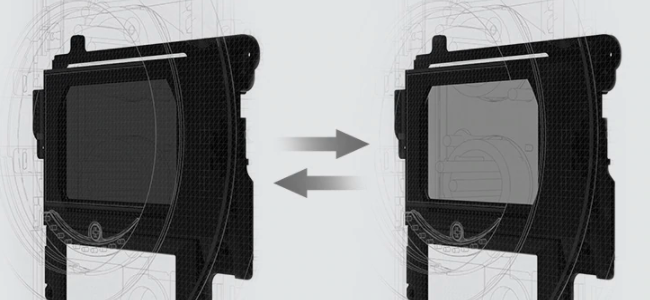
There is also an ND auto setting just like on the FX6 and FX9. ND auto lets you keep your ISO, shutter speed and f-stop locked and then the electronic ND will automatically make adjustments to keep your exposure correct. With this system, you can also do things like adjusting the depth of field in real-time as the variable ND will compensate automatically when you make changes to the f-stop.
The Electronic Variable ND system on the Sony cameras is really impressive. It is simple and easy to use and one of the FR7’s stand-out features.
Interchangeable Lenses
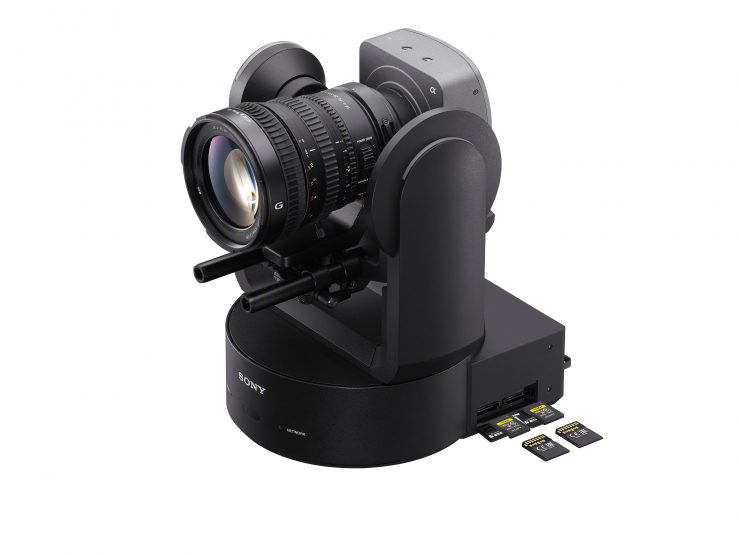
As the FR7 utilizes Sony’s E-mount you can use a very wide array of lenses with the camera. This greatly increases its versatility and allows it to be used for a host of different applications.
Having the ability to utilize a full-frame sensor with great low light capabilities and a fast lens is going to be perfect for concerts and other live events.
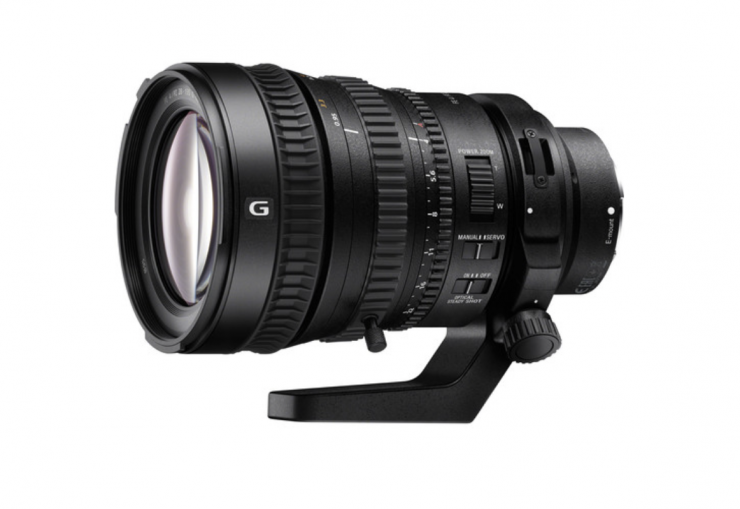
The only real caveat is that Sony only has a handful of E-mount lenses with an integrated power zoom that cover full frame. If you wanted to use manual focus lenses or lightweight cinema zooms you could rig up your own remote follow focus or FIZ system utilizing 15mm rods, however, this would all have to be controlled separately.
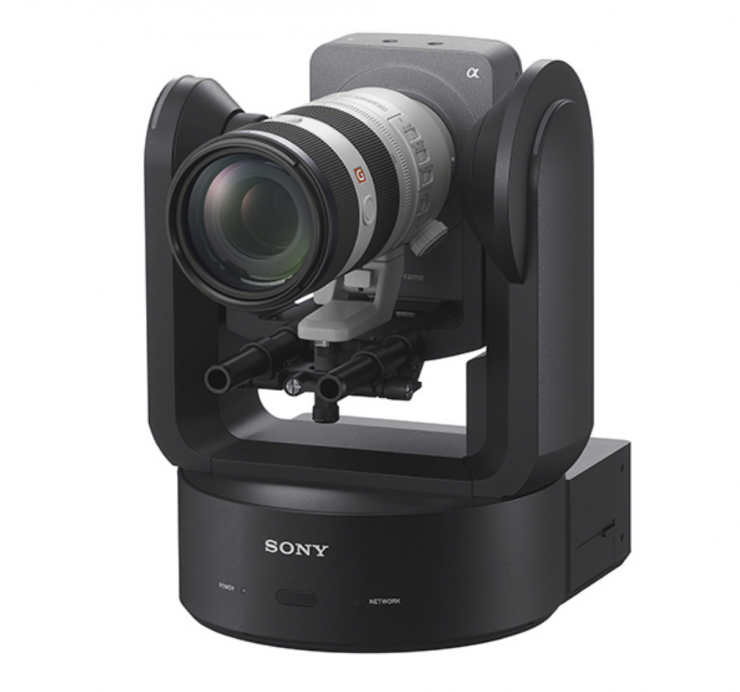
As far as the maximum sized lenses you can use on the FR7, Sony told me that it will take up to a FE 70-200mm f/2.8 GM OSS II Lens with a FE 2x Teleconverter.
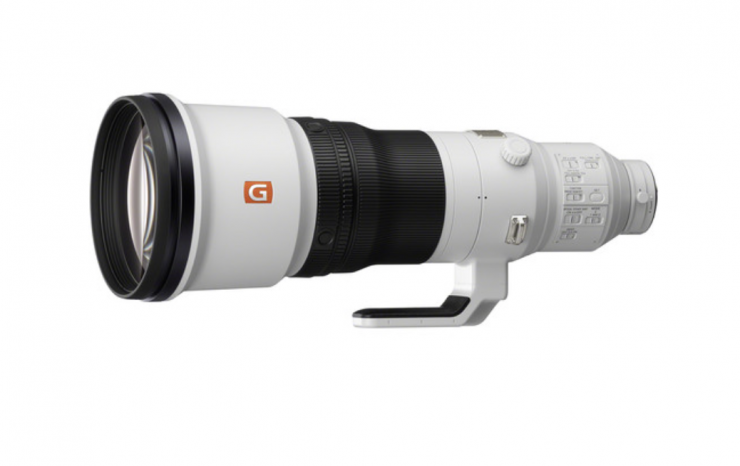
You can also put larger lenses on it like a Sony FE 600mm f/4 GM OSS, Sony FE 400mm f/2.8 GM OSS, Sony FE 100-400mm f/4.5-5.6 GM OSS, and Sony FE 200-600mm f/5.6-6.3 G OSS, but then the FR7 needs to be locked and you lose the ability to pan and tilt.
In no real surprise, that the FR7, just like the FX3 and FX6, doesn’t have the same locking E-mount found on the FS7 M2 and FX9. It features a regular E-mount. This mount is fully compatible with E-Mount lenses and supports all electronic connections.
Not having a locking E-mount means you really do need to use lens support for certain larger lenses. With a locking mount, it reduces lens play and allows you to use most 35mm lenses including PL, EF, Leica, and Nikon via optional adapters. That stronger E-mount is also handy for using heavier-long cine-zooms without having to add additional lens support.
Personally, I don’t think it is of any real concern that this camera doesn’t have a locking E-mount.
Recording Capabilities
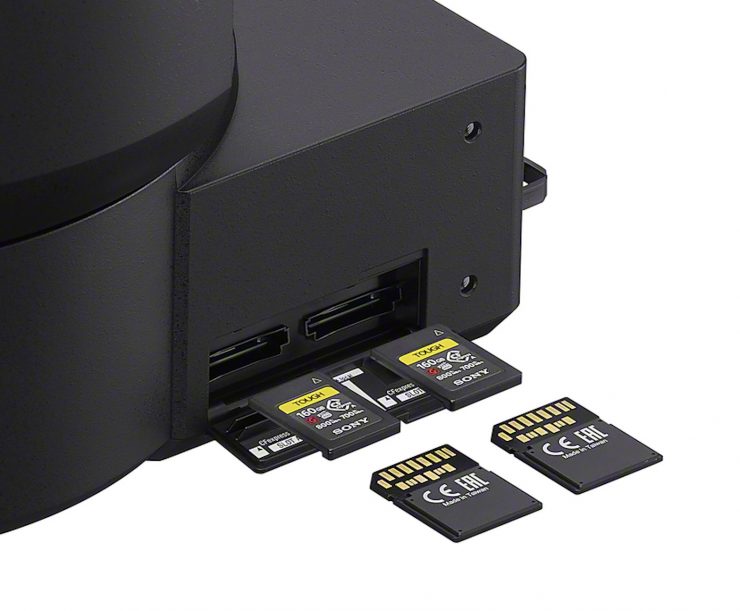
The FR7 does feature onboard recording capabilities. It has dual slots for CFexpress Type A or SD/SDHC/SDXC cards.
The FR7 can record in 4K DCI, UHD, or HD in various flavors of XAVC at up to 600Mb/s. Essentially, it has the same recording options as the FX6.
You can record all these XAVC options on either a CFexpress Type A card or
If you don’t want to record in 4:2:2 10-bit you can also choose to record in 4:2:0 10-bit or 4.2.0 8-bit at lower bitrates as well.
The FR7 can capture 4K DCI at up to 59.94P in 4:2:2 10-bit XAVC Intra (Class 300). In UHD it can capture up to 120P also in 4:2:2 10-bit XAVC Intra (Class 300). Sony doesn’t specifically state what the bitrate is when recording UHD at 100 or 120P. One thing you need to be aware of is that the camera can’t shoot in 4K DCI in frame rates above 59.94p.
There are also XAVC Long GOP recording options as well if you want to minimize card space.
XAVC Intra 422 10-bit (Class 300)
| RESOLUTION | SYSTEM FREQUENCY | BITRATE |
| 4K DCI (4096×2160)* | 59.94P 50P 29.97P 25P 24P/23.98P | 600 Mbps 500 Mbps 300 Mbps 250 Mbps 240 Mbps |
| UHD (3840×2160)** | 59.94P 50P 29.97P 25P 24P/23.98P | 600 Mbps 500 Mbps 300 Mbps 250 Mbps 240 Mbps |
*S&Q from 1-60fps is available in these modes, however, it isn’t available if you are outputting RAW over SDI.
**S&Q 1-60fps and 100/120fps are available in these modes, however, 100/120fps is not available when outputting RAW over SDI.
XAVC Intra 422 10-bit (Class 100)
| RESOLUTION | SYSTEM FREQUENCY | BITRATE |
| FHD (1920×1080* | 59.94P 50P 29.97P 25P 24P/23.98P | 600 Mbps 500 Mbps 300 Mbps 250 Mbps 240 Mbps |
*S&Q 1-60fps and 100/120/200/240fps are available in these modes.
Please be aware that 100/120/200/240fps are only available in the full-frame shooting mode. They don’t work in the S35 mode.
XAVC Long GOP 420 8-bit
| RESOLUTION | SYSTEM FREQUENCY | BITRATE |
| UHD (3840×2160)* | 59.94P 50P 29.97P 25P 24P/23.98P | 150 Mbps 150 Mbps 100 Mbps 100 Mbps 100 Mbps |
*S&Q 1-60fps and 100/120fps available in these modes.
XAVC Long GOP 422 10-bit
| RESOLUTION | SYSTEM FREQUENCY | BITRATE |
| FHD (1920×1080)* | 59.94P 50P 29.97P 25P 24P/23.98P | 50 Mbps 50 Mbps 50 Mbps 50 Mbps 50 Mbps |
*S&Q 1-60fps and 100/120/200/240fps are available in these modes.
Please be aware that 100/120/200/240fps are only available in the full-frame shooting mode. They don’t work in the S35 mode.
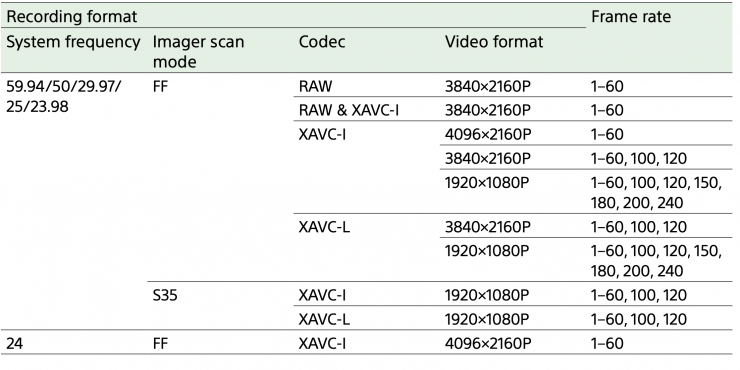
Above you can see what you can do if you are shooting in S&Q. The auto focus function, auto iris function, and auto shutter function are disabled in Slow & Quick Motion mode. However, the auto focus function can be used
the frame rate is set to the following:
System frequency Frame rate
59.94/29.97/23.98 30, 60, 120, 240
50/25 25, 50, 100, 200
Both Proxy Video and Audio can be recorded:
- PROXY AUDIO XAVC Proxy: AAC-LC, 128 kbps, 2 channels
- PROXY VIDEO XAVC Proxy: AVC/H.264 High Profile 4:2:0 Long GOP, VBR 1920×1080, 9Mbps
An HLG (Hybrid Log-Gamma) HDR picture profile, complete with the wide-gamut BT.2020 color space, can be used for direct HDR (HLG) playback on compatible TVs.
These are all good options and it is nice to see that Sony has offered shooters a variety of different forms of XAVC to choose from depending on what their needs may be.
You can choose to shoot in HDR-HLG, S Cinetone, Sony S-Log 2, Sony S-Log 3, or Standard picture profiles. There is also a Cine EI mode.
With patent issues prohibiting internal compressed RAW recording, the FR7 is only capable of recording RAW externally. Just like the FX3 and FX6, you can output RAW over SDI to an Atomos Ninja V or V+.
With the FR7 you can output the exact same 4.2K (4264 x 2408) up to 59.94p 16-bit linear RAW signal as you can from the FX6. This signal is then recorded as 12-bit ProRes RAW file. Both the SHOGUN CONNECT and NINJA V+ can also record 4K 100p and 4K 120p.
Now, the biggest downside when utilizing a smaller megapixel 4K sensor is that you can only record UHD in full-frame. If you switch to the 1.5x S35 shooting mode you are limited to recording in HD. You need to be aware of this because it is going to have serious limitations with focal reach. However, in saying all of this, a lot of live applications are only going to be transmitting HD anyway. You could also record in UHD on the camera and output a live HD signal.
Clear Scan Zoom
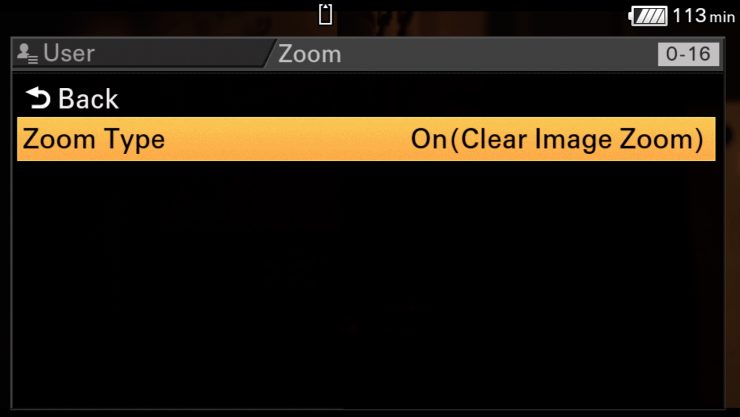
The FR7 does have a Clear Image Zoom setting. What this allows you to do is to create a small zoom in or zoom out. You can control it using the app, or a Sony PTZ controller. As the FR7 has no ability to shoot UHD or 4K DCI in its S35 mode, the Clear Image Zoom can come in handy.
AF
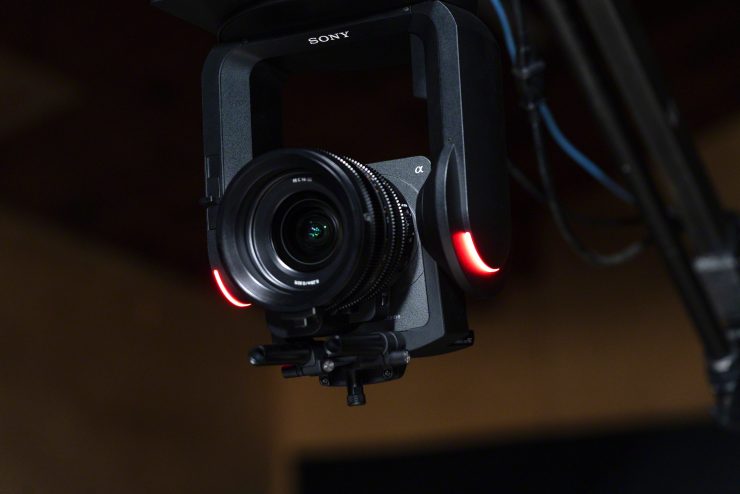
The FR7 has all of the same AF performance attributes of the a7S III, FX3, and FX6.
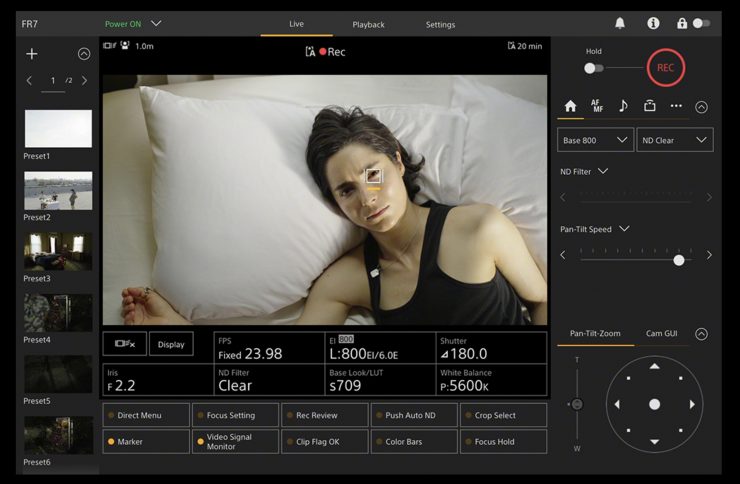
The FR7, just like the FX3, FX6, and a7S III, features a next-generation sensor chipset that provides much improved AF with face detection and Eye-AF.
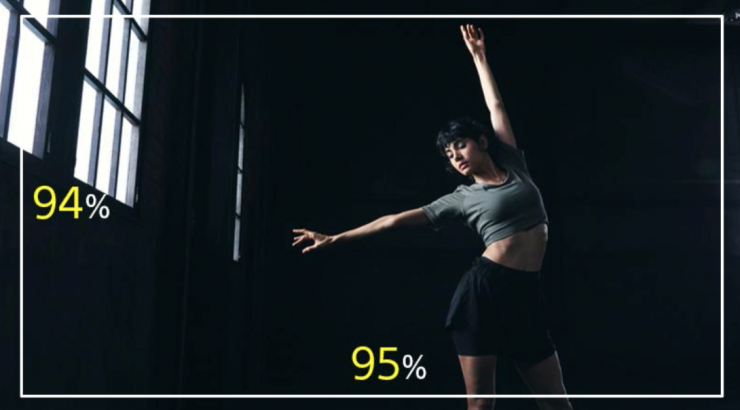
The enhanced Fast Hybrid AF system has customizable AF transition speeds and sensitivity settings, and also combines phase-detection AF for fast, accurate subject tracking with contrast AF for exceptional focus accuracy. The dedicated 627-point phase-detection AF sensor covers approximately 95% in width and 94% in height of the imaging area. Sony claims that this provides consistently accurate, responsive AF tracking, even with fast-moving subjects while maintaining a shallow depth of field.
Again, the AF is the exact same system that is being used in the FX3, FX6, and a7S III.
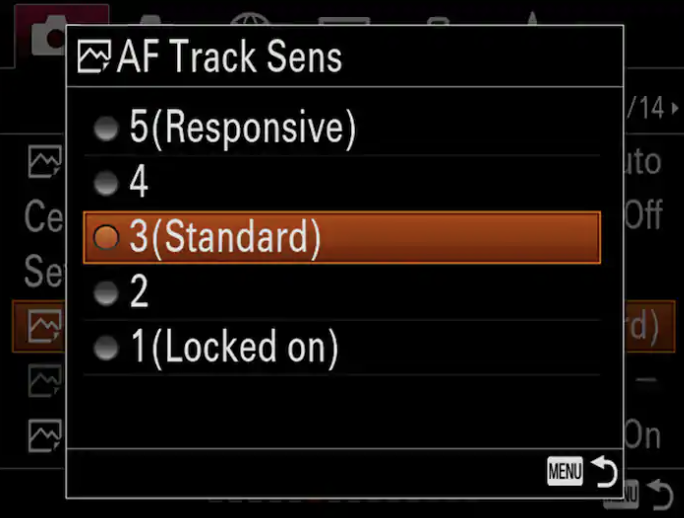
There are five-level AF transition speeds from fast-switching between subjects as quickly as possible to slow, where speed is reduced to fit a more measured shooting style.
Five-level AF subject shift sensitivity ranges from locked-on, ignoring other moving subjects in the frame, to responsive focus that switches from one subject to another.
You can simply touch the tablet or smartphone screen that is running the FR7 software to make AF changes.
The AF works in all resolutions and all frame rates, including UHD at 120p and HD up to 240p. The AF system is also claimed to work really well in low-light situations. Sony has really improved its AF technology in recent years and it is sure to be a big selling point for people who are looking for a PTZ camera.
| AUTO FOCUS TYPE | Hybrid AF (phase-detection AF / contrast-detection AF) |
| FOCUS POINTS (35-mm full frame) | 759 points (phase-detection AF) |
| FOCUS POINTS (APS-C mode with FF lens) | 345 points (phase-detection AF) |
| FOCUS POINTS (APS-C lens) | 285 points (phase-detection AF) / 425 points (contrast-detection AF) |
| FOCUS SENSITIVITY RANGE | EV-6 to EV20 (ISO 100 equivalent with F2.0 lens attached) |
| FOCUS MODES | AF-A (Automatic AF), AF-S (Single-shot AF), AF-C (Continuous AF), DMF (Direct Manual Focus), Manual Focus |
| FOCUS AREA | Wide / Zone / Center / Flexible Spot / Expanded Flexible Spot / Tracking |
| EYE AF | [Still images] Human (Right/Left Eye Select) / Animal, [Movie] Human (Right/Left Eye Select) |
| OTHER FEATURES | Predictive control, Focus lock, AF Track Sens. (Still), AF Subj. Shift Sensitivity (Movie), AF Transition Speed (Movie), Switch V/H AF Area, AF Area Regist., Circ. of Focus Point |
| AF ILLUMINATOR | Approx. 0.98 ft – approx. 0.98 ft (with FE 28-70 mm F3.5–5.6 OSS lens attached) |
What can it output?
The FR7 can output the following resolutions and frame rates:
SDI
4096 x 2160: 59.94p, 50p, 29.97p, 25p, 24p, 23.98p / 3840 x 2160: 59.94p, 50p, 29.97p, 25p, 23.98p / 1920 x 1080 : 59.94p, 50p, 59.94i, 50i, 29.97p, 25p, 24p, 23.98p, 29.97PsF, 25PsF
HDMI
4096 x 2160: 59.94p, 50p, 29.97p, 25p, 24p, 23.98p / 3840 x 2160: 59.94p, 50p, 29.97p, 25p, 23.98p / 1920 x 1080: 59.94p, 50p, 59.94i, 50i, 29.97p, 25p, 24p, 23.98p / 720 x 480: 59.94p / 720 x 576: 50p
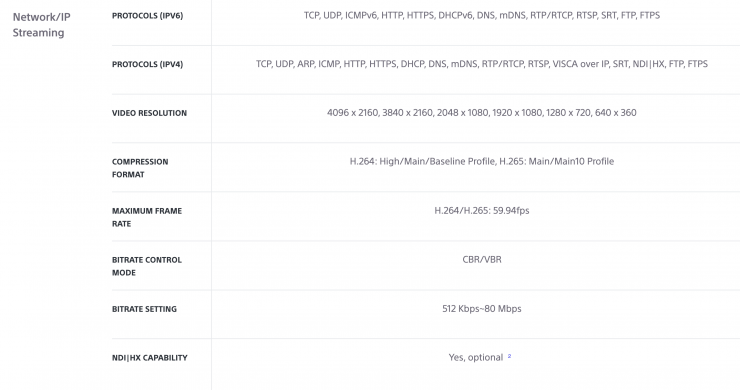
Above you can see the Network/ IP streaming protocols, resolution, compression format, and bitrates.
How do you control the FR7?
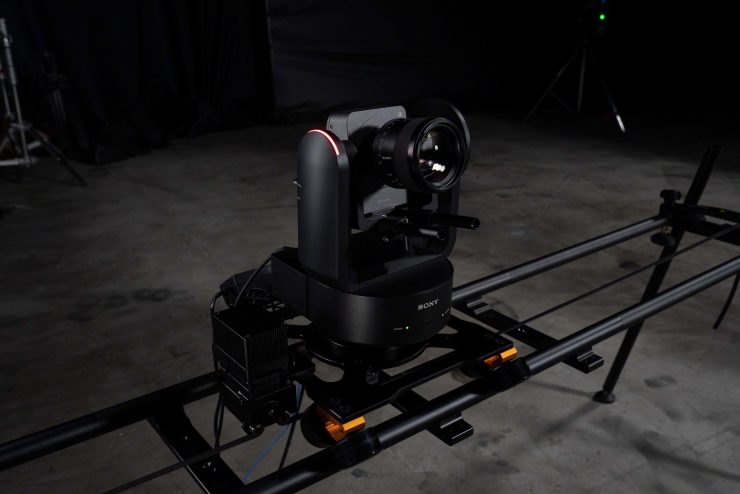
The FR7 can be controlled via a free iOS or Android app or via Sony’s RM-IP500/1 Professional Remote Controller.
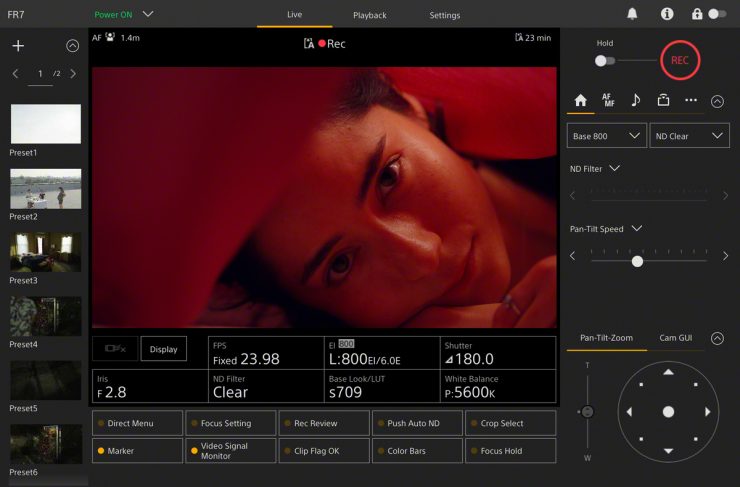
With a new dedicated web application, pan, tilt, zoom, focus, record, playback, and all camera settings can be controlled from a tablet or computer web browser. Multiple people can monitor FR7 footage remotely at the same time. Multi-camera monitoring allows multiple cameras to be viewed remotely on one device. With its integrated remotely controllable pan/tilt mechanism, the FR7 can be mounted on a tripod, or on a ceiling with the dedicated CIB-PCM1, or in other locations with limited access.
I had a chance to try out the app and it works pretty well. You can control the speed of moves, the speed of the AF, zoom (if you are using a compatible lens) and you have complete control over the camera.
You can pre-program moves and the speed between those moves and then save them and recall them when needed. You can also change the camera’s ISO, shutter speed, f-stop, picture profile, frame rate, etc.
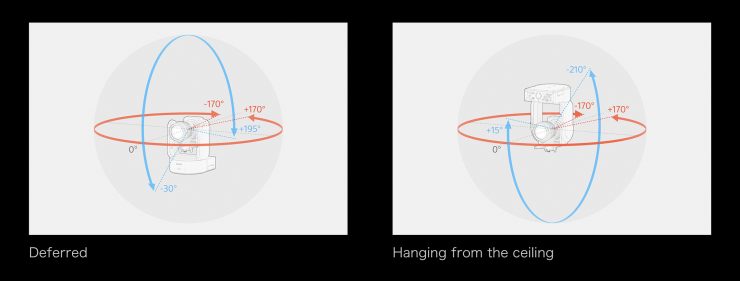
The pan and tilt speed can be continuously varied from 0.02 degrees per second to 60 degrees per second. The pan angle range is from -170° to +170°, and the tilt angle range is from -30° to +195°.
The FR7 can memorize up to 100 camera position presets, and the built-in web application and optional RM-IP500 remote controller also allow up to 100 camera position presets to be recalled. Presets include camera direction, zoom, and focus. The FR7 will also support S700 protocol via Ethernet, enabling control of this product from Sony’s Remote Control Panel (RCP) and Master Setup Unit (MSU) with a firmware update.
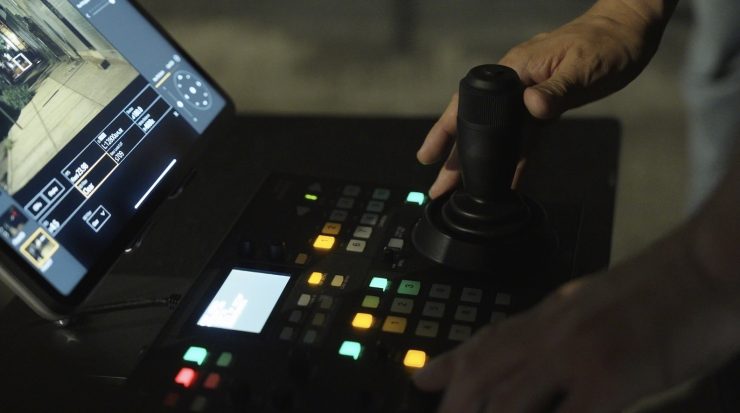
The RM-IP500/1 Professional Remote Controller also works well, especially for creating smooth moves.
Sony also includes a remote control with the FR7 that you can use for making changes to basic functionality.
No Tracking
While the FR7 can do focus tracking, the PTZ itself cannot do any type of motion tracking automatically. It would have been good to see Sony incorporate a system where the PTZ camera will automatically track subjects and move when they move. This is something that we have seen implemented on gimbals and quite a few webcams.
Inputs & Outputs
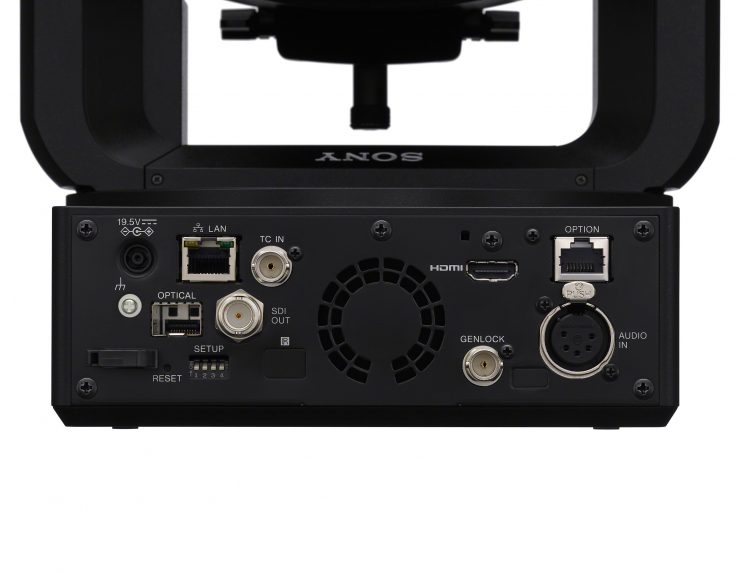
The FR7 was designed to integrate and adapt to many workflow scenarios, from simple plug and play to more complex high-end productions. It features a comprehensive selection of video inputs and outputs, IP streaming, power supply, and synchronization with other devices.
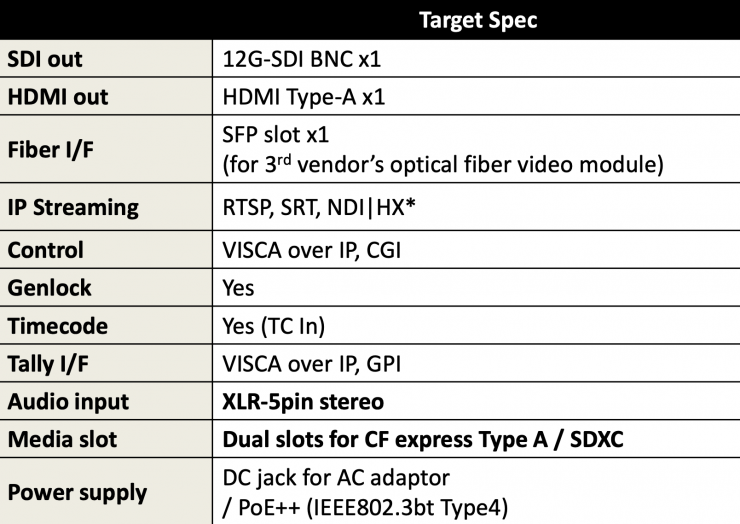
The FR7 has the following inputs and outputs:
- 12G-SDI Out
- TC In
- HDMI Type A Out
- Genlock
- Optical Fiber (SFP slot)
- LAN
- Tally I/F (VISCA over IP, CGI)
- 5-pin Audio Input
- Dual slots for CF express Type A / SDXC
- Option Port
- 19.5V power input (DC jack for AC adaptor / PoE++ (IEEE802.3bt Type4)
It is nice to see a 12G-SDI and an HDMI Type A.
Ethernet connectivity allows for camera control, video and audio transfer, and power supply can also be carried out via a single LAN cable.
The FR7 LAN (network) connector supports a variety of streaming protocols, including RTSP, SRT, and NDI |HX, for working in an IP-based environment. An NDI|HX Upgrade must be purchased from NewTek.
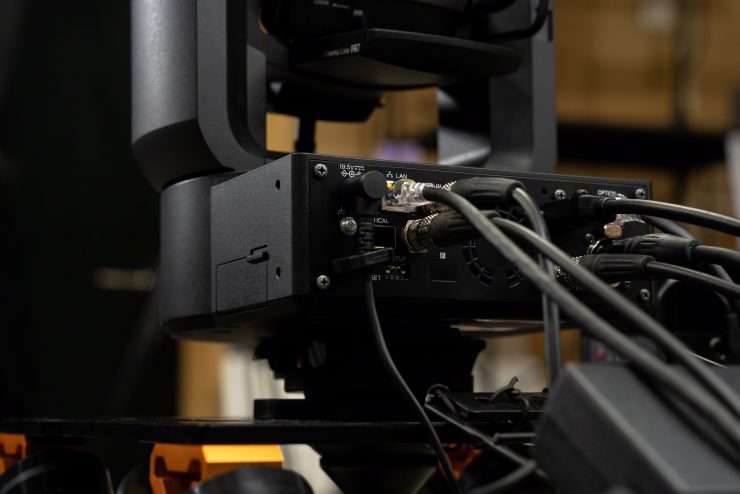
You can control the camera over Wi-Fi, or LAN. If you need to run signals over large distances where SDI or HDMI won’t suffice you can do so via an optical fiber cable. You can’t daisy chain multiple FR7 cameras together like you can with some other PTZ options.
The FR7 can be powered from an external PoE++ (Power over Ethernet Plus Plus) device via a standard network cable, eliminating the need for separate power supply cabling.
What I thought was a missed opportunity is that you can’t remotely power the FR7 from a standard 14.4V camera battery.
The Timecode IN connector receives timecode for synchronization with an external device, while the GENLOCK receives synchronization signals in multi-camera setups. It is nice that you can input a BNC timecode source as well as attach a microphone or audio source through the 5-pin audio input.
Red/green tally lights are provided on the camera’s side panels, which allows performers and staff to easily identify the on-air and preview cameras in multi-camera setups in a studio or on location.
Size & Weight
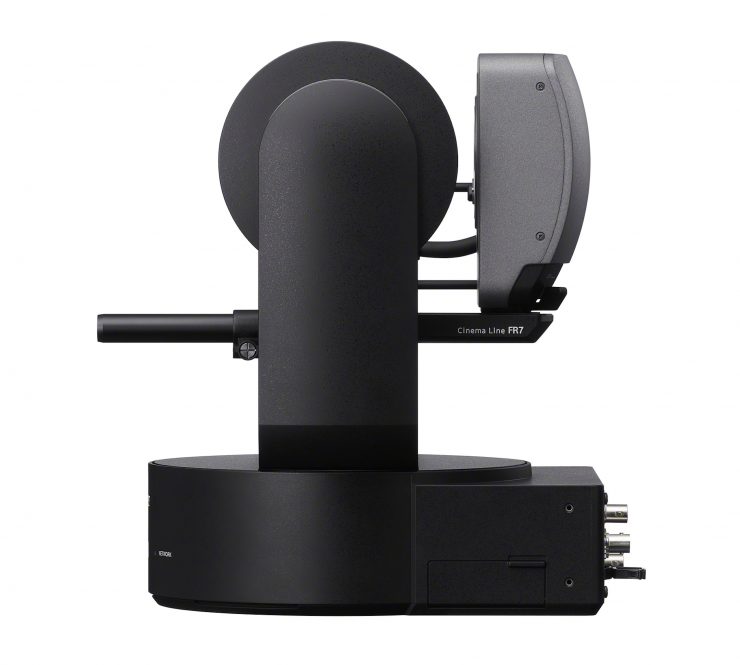
The FR7 is not lightweight, it tips the scales at 4.7 kg / 10.36 lb without a lens.
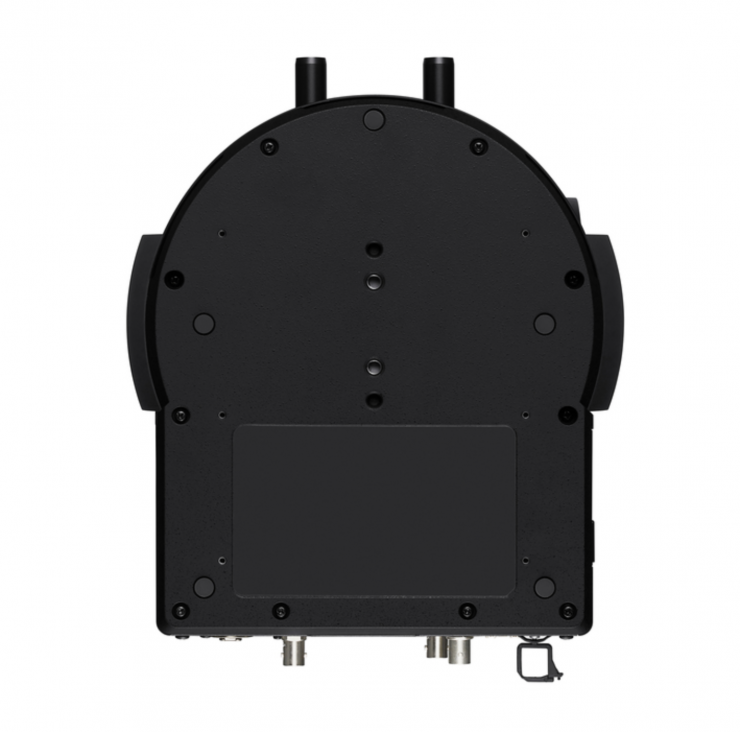
On the base of the FR7, there are two single 1/4-20″ threads.
How do you balance it?
Balancing the FR7 is pretty easy. There is only one adjustment and that is for sliding the camera/lens combo forward or back.
The FR7 has already been used on a reality TV show (a cooking competition) and on a major concert as part of a 24 camera setup.
Full Specifications
Price & availability
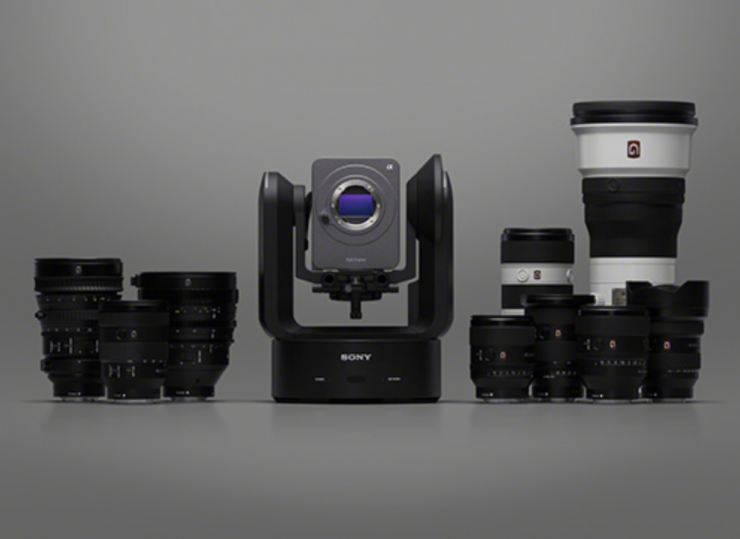
The new FR7 will be available in November 2022 for $9699.99 USD and $12,399.99 CAD.
A kit version called the FR7K, which includes the FR7 and SELP28135G lens, will be available for $12,199.99 USD and $15,699.99 CAD.
The optional CIB-PCM1 ceiling bracket will be available for $119.99 USD and $159.99 CAD.
The FR7 will be showcased for the first time at Sony’s booth at IBC 2022 in Amsterdam from September 9th to 12th.

